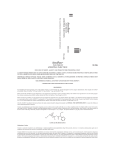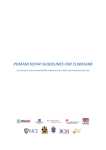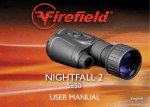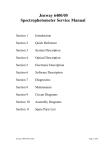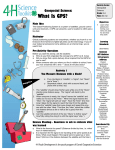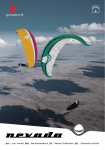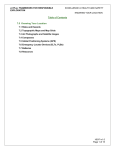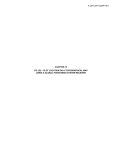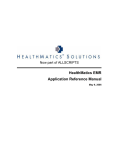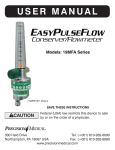Download GO2Altitude® HYPOXICATOR (High Altitude Simulator
Transcript
GO2Altitude® HYPOXICATOR (High Altitude Simulator) PC SOFTWARE MANUAL © 2003 BIOMEDTECH Australia Pty Ltd GO2Altitude® Software Manual 1 TABLE OF CONTENTS THE GO2ALTITUDE® SOFTWARE SESSION SCREEN ....................................................2 THE GO2ALTITUDE® SOFTWARE HISTORY SCREEN ...................................................3 REAL-TIME SCREEN FUNCTIONS.......................................................................3 REAL-TIME SCREEN FUNCTIONS.......................................................................4 OVERVIEW ...................................................................................................................4 The Graphical Display Window ...............................................................................4 FUNCTION CONTROLS ..................................................................................................4 Control Buttons.........................................................................................................4 Message Display Window.........................................................................................5 Time Interval and Message Size Buttons ..................................................................6 SpO2 Baseline Levels ................................................................................................6 Heart Rate and Show Buttons...................................................................................7 Station and Mode Selection ......................................................................................7 HYPOXIC TEST .............................................................................................................8 Messages Displayed..................................................................................................9 HISTORY SCREEN FUNCTIONS .........................................................................10 OVERVIEW .................................................................................................................10 Loading session data ..............................................................................................10 The Graphical Display Window – Session Statistics ..............................................12 FUNCTION CONTROLS ................................................................................................12 Control Buttons.......................................................................................................12 Data Manipulation and Export...............................................................................13 The Graphical Display Window – Global Statistics...............................................14 CONTROL BUTTONS ...................................................................................................15 Course Statistics .....................................................................................................16 OPERATION OF THE GO2ALTITUDE® SOFTWARE ....................................17 PRELIMINARIES ..........................................................................................................17 Recording a Session................................................................................................18 “SKIN” DISPLAY OPTIONS ..........................................................................................19 GLOSSARY..................................................................................................................20 © 2003 BIOMEDTECH Australia Pty Ltd 2 GO2Altitude Software Manual Program Overview GO2Altitude® software consists of two separate modules – a real-time Graphical User Interface (GUI) used to monitor hypoxic training sessions, and another GUI specifically designed to view, manipulate, access, and store data from a history of hypoxic training sessions. Each module is selected from a specific icon located on the computer desktop during installation of the software. Each of these systems will be explained in turn. The user may also select from two distinctive “skins” for their GO2ALTITUDE® display, when the program is started. For the sake of clarity, this manual will use the “CRT” skin (see the Skin Display Options section for further information). The GO2Altitude® Software Session Screen GO2Altitude® software is specifically designed to complement the GO2Altitude® range of hypoxicator systems. Utilising the GO2Altitude® integral Pulse Oximeter (see Pulse Oximeter in Glossary at the end of this manual), physiological information - such as heart rate and arterial oxygen saturation - is monitored, recorded, and displayed on a standard, Windows-based computer during intermittent hypoxic training sessions. This information is then used to assist in determining the current state of an individual’s fitness, their reaction to hypoxic stimulation, and the degree to which their body has responded to the treatment. The information received by the GO2Altitude® software is displayed on a multi-function screen that plots the various input parameters – heartbeat, O2 saturation – against specified time intervals. The GO2Altitude Software Session Screen The Graphical Display Window Time intervals and message size Control buttons Show arterial O2 saturation baseline Heart rate Station and mode selection Message display © 2003 BIOMEDTECH Australia Pty Ltd GO2Altitude® Software Manual 3 The GO2Altitude® Software History Screen In addition to the Software Session Screen, the GO2Altitude® Software System also allows the user to access and compare stored data from a history of hypoxic sessions, to assist in the analysis of their training regime. The information displayed may be stored on the host computer, be printed as required, or manipulated in a variety of other ways, including export to a spreadsheet program (such as MS Excel) or to a database (such as MS Access), as a delimited text file. Each of the functional areas shown will be discussed in turn in the following sections of this manual. Graphic display window Statistics mode buttons Time intervals Graph control buttons and Help User and session selection Data manipulation and export © 2003 BIOMEDTECH Australia Pty Ltd 4 GO2Altitude Software Manual Real-time Screen Functions Overview The GO2Altitude® Software User Screen is accessed from its specific icon on the computer desktop: To more clearly describe the screen functions, the main screen will be explained in two sections corresponding to the titles shown in the graphic,GO2Altitude® Software User Screen. The first section describes the Graphical Display Window, whilst the second section describes the Function Controls and the smaller Message Display screen: The Graphical Display Window Heart rate scale SpO2 level Hypoxic air versus ambient air intake Station monitored Current user Elapsed session time As illustrated, the Graphical Display Window shows the real-time data of the Selected Station (see Stations in the section Function Controls) in a comparative graphical form. As such, this window shows the variance in Heart Rate and Arterial Oxygen Saturation (SpO2 ) over a given period of time. Function Controls Control Buttons The Control Buttons are located on the lower left section of the GO2Altitude® Hypoxicator software screen. The function of each of these buttons is as follows: © 2003 BIOMEDTECH Australia Pty Ltd GO2Altitude® Software Manual 5 Help Calls the GO2Altitude® Hypoxicator online help manual Alarm Enables the warning buzzer to indicate that oxygenation levels are too low. The inbuilt green light glows when the button is activated. The Reset button clears resets the software and clears the screen to allow taking of new measurements. Messages Selecting this button enables messages in the Message Display window: Message Display Window Located to the right below the Control Buttons, is the Message Display Window: SpO2 SpO2 Heart rate Station(s) activity Heart rate The Message Display Window shows the information obtained from a selected station, and is a real-time textual representation of the information shown in the Graphical Display Window. The data exhibited includes the Station Number being used – represented as a number with a hash (#) on the left of the display, and as a list number on the right side of the window. The SpO 2 is shown as a percentage, and the heart rate is given in Beats Per Minute (BPM). The information is displayed in a larger form to the left of the window to allow for reading from a distance, for example when the user is seated some distance from the computer. © 2003 BIOMEDTECH Australia Pty Ltd 6 GO2Altitude Software Manual Time Interval and Message Size Buttons The Time interval and Message Size buttons are located on the lower right portion of the GO2Altitude® Software Session screen, previously described. The Display button simply enables the viewing of the larger message on the left-hand portion of the Message Display Window previously described (see Message Display Window). The inbuilt green light glows when the button is activated. The Time Interval buttons alter the time increment shown on the Graphical Display Window. Each interval can be changed to a preset selection of 10, 30, or 60 minutes, as shown in the following section from the Graphical Display Window: Time increments Total = 10 minutes SpO2 Baseline Levels Show – This button enables the display of Saturated blood O2 levels. SpO2 – These scroll buttons permit the setting of the baseline level of the percentage of arterial blood oxygen saturation, below which level the software will start to alarm the operator. © 2003 BIOMEDTECH Australia Pty Ltd GO2Altitude® Software Manual 7 Heart Rate and Show Buttons Simply, these buttons set the baseline Heart Rate, above which the program starts to alarm. Station and Mode Selection The Station and Mode Selection buttons are located in the lower portion of the GO2Altitude® Software User Screen, directly to the left of the Message Display Window. The function of these buttons is as follows: Stations – Dependent on the model of hypoxicator used, if more than one station is in use, this function allows the operator to select which station information is to be displayed. Clicking this button to display the details of the station monitored will also result in the illumination of a confirmation “on” light, next to the button concerned. If no stations are activated, the selection buttons are unavailable (greyed out). When a station is activated and the program of treatment is started, its corresponding button becomes active. Mode Selection - The New Session button simply allows the operator to initiate a new session, and select a station (if applicable). The Stop and Stop All buttons put a halt to any current session or sessions, respectively. The user must select the New Session button to reinitiate a session. The Hypo. Test button is used to start the special mode; Hypoxic Test. © 2003 BIOMEDTECH Australia Pty Ltd 8 GO2Altitude Software Manual Hypoxic Test In order to determine a user’s respiratory condition and to determine the base level reference of their fitness health level, a hypoxic test is recommended. The information is collected over a maximum period of ten minutes, where the Pulse Oximeter (finger clip-on sensor) is used to measure heart rate and SpO 2, levels and the results are displayed graphically using the GO2Altitude® software. This is performed in real-time, with a one second sampling frequency: SpO2 scale SpO2 base level set Heart rate base level set Heart rate scale Station in use Person being tested Elapsed time The Hypoxic Test helps indicate an individual’s reaction to low-oxygen respiration. By default, or by connection, the oxygen saturation base line is set automatically to 85% for all people (Please refer to the main Hypoxicator User Manual for further information). The results of this test are also displayed textually in the Message Display window, simultaneously: Combined results SpO2 Heart rate © 2003 BIOMEDTECH Australia Pty Ltd Station activity GO2Altitude® Software Manual 9 Messages Displayed The Hypoxic Test screen continuously plots a graph of SpO 2 and Heart Rate on the screen at one-second intervals as the hypoxic test is being conducted: One result of this test is known as the Time to Descend – or Td. This figure is displayed constantly in the lower right-hand portion of the Hypoxic Test display window (as shown), and actively refers to the time taken for the user’s SpO2 level falls below 85%. NOTE As a rule-of-thumb, the length of the Td parameter reflects the level of general respiratory and aerobic fitness of an individual. Generally, the longer the Td, the higher the fitness level of the person under test. Once the Td has been reached, the user is advised by the software to remove the mask, and revert to breathing ambient air. From here, the recovery test is started when an SpO 2 level of 95% is reached, and is measured as Tr, or Time to Recovery, and is shown with the Td measurement in the display window, as illustrated. Once the Hypoxic Test has been conducted, a dialog box will be displayed showing both the Td and Tr results (as shown at left). From here, the user may elect to save, print, or email the information. © 2003 BIOMEDTECH Australia Pty Ltd 10 GO2Altitude Software Manual History Screen Functions Overview To access the History screen, the operator selects the GO2Altitude® History icon from their PC desktop, as shown at left. Loading session data Once the GO2Altitude® History icon has been selected, a dialog will display as follows: For new users, click on the OK button only For previous users, click on the Import V.2 sessions… button to load saved session data from previous versions of the software. This will then display a dialog in which the operator may browse for suitable files: Once the appropriate files have been selected, click on the Import button to load them to the GO2Altitude® History screen. When complete, a message window will display, confirming the number of files imported. Files may now be accessed directly from within the GO2Altitude® History display from selected training sessions. © 2003 BIOMEDTECH Australia Pty Ltd GO2Altitude® Software Manual 11 User and Session Selection To access an individual session, or sessions, the operator now chooses from a group of drop-down boxes: Directly below the Measurement Control buttons is a series of drop-down boxes that contain information pertinent to the data being displayed on the Graphical Display Window. The first of these windows displays the User selected, to display their hypoxic test history. Only those users whose data is stored may be accessed. Each session is stored separately, and may be accessed from this drop-down list. The Test Session, containing the date, time, and standard oxygen concentration level, are selected here. As illustrated, this Window shows the collected history data of the Selected session in a comparative graphical form. As such, this window shows the variance in Heart Rate and SpO2 levels over a given period of time, during a selected session: Saturated O2 scale Test session details Heart Rate scale Precise point measurement Time to Descend © 2003 BIOMEDTECH Australia Pty Ltd Person in test history Time to Recovery 12 GO2Altitude Software Manual The Graphical Display Window – Session Statistics To more clearly describe the screen functions, the main screen will be explained in two sections corresponding to the titles shown in the graphic, GO2Altitude® Software History Screen. The first section describes the Graphical Display Window, whilst the second section describes the Function Controls and the smaller Message Display screen. The GO2ALTITUDE® History Software Graphical Display Window consists of several distinct functions. There are two displays from which to choose, the Session Statistics function, and the Global Statistics function, each of which is selected from the button found in the centre of the display, directly below the Graphical Display Window. These buttons toggle between the two functions, and the display and controls change accordingly. The first of these, the Session Statistics mode, is as follows. Function Controls Control Buttons The Control Buttons are located on the lower left section of the GO2ALTITUDE® History software screen. The function of each of these buttons is as follows: Help Calls the GO2Altitude® Hypoxicator online help manual Measurements Calls into action the precise point measurement lines used to display detailed data at a given section of the displayed graph. By positioning the cursor at the point required and clicking the left mouse button, a line of measurement will be inserted, and the data for that point displayed: © 2003 BIOMEDTECH Australia Pty Ltd GO2Altitude® Software Manual 13 These precise point measurements are particularly useful in displaying the heart rate or an exact percentage of SpO2 at any given time. Each measurement line is movable across the range, and multiple measurement lines may be inserted. The Move buttons control the incremental movement of the measurement lines. Clicking the button denoting a left or right direction will move the line in that direction. Dragging with the mouse will also effect this. The Time Interval buttons alter the time increment shown on the Graphical Display Window. Each interval can be changed to a preset selection of 10, 30, or 60 minutes Data Manipulation and Export Directly to the right, and on the same level of the Message Display boxes, are the Function Buttons: The Clean-up Data checkbox smooths the graphical data displayed, by averaging the measurements to remove the strictly linear appearance. The Print Graph button outputs the graphical display directly to a printer connected to the computer. The Export to Excel button allows the user to transfer the history results directly into the spreadsheet program, MS Excel, as a delimited text file. This results in the user being able to further manipulate, store, and display the collected history data: © 2003 BIOMEDTECH Australia Pty Ltd 14 GO2Altitude Software Manual The information shown in Excel may be then transformed into any of the graphical display methods available, including graphs, and pie, column, and line charts. The Graphical Display Window – Global Statistics The inverse toggle to the Session Statistics mode is the Global Statistics mode. This mode displays a summary of all sessions undertaken. Selecting this mode changes the Graphical Display Window contents, as well as the function and selection buttons relevant to use in this mode: Independent of the session(s) selected, the Graphical Display Window will display certain parameters: SpO2 scale Overall Session(s) statistics Heart rate scale Average SpO2 achieved Minimum SpO2 Maximum Heart rate Average Heart rate User selected Time to Descend © 2003 BIOMEDTECH Australia Pty Ltd Time to Recovery GO2Altitude® Software Manual 15 Control Buttons The functions allocated in Global Statistics mode are fundamentally the same as those available in the Session Statistics mode (see Control Buttons in the section Session Statistics for the correct use of these buttons), with the exception of an additional checkbox: The full STAT, or “Full Statistics”, button is used to display all recorded sessions as a function of saturated blood oxygen levels and heart rate linearly: The user is also able to print, store, and export to MS Excel, all the data contained within this screen. From within MS Excel, the user may also manipulate the data to display other types of graphs, for example: © 2003 BIOMEDTECH Australia Pty Ltd 16 GO2Altitude Software Manual Course Statistics Within the GO2Altitude® History display screen, there is also the Course Statistics checkbox. Located directly to the right of the Global and Session Statistics buttons, the Course Statistics checkbox, when selected, displays the statistical averages recorded over a range of hypoxic training sessions: Each Hypoxic training session is displayed in a range scaled according to the number of sessions, with the date and time details shown on the lowermost part of the graph, and the SpO2 and Heart Rate parameter minimums and maximums displayed in the uppermost portion of the same window. Again, data may be exported to another program for table and/or graphical manipulation. © 2003 BIOMEDTECH Australia Pty Ltd GO2Altitude® Software Manual 17 Operation of the GO2Altitude® Software Preliminaries After the installation of the software to the computer and the supplied serial cable is connected to both the GO2Altitude® Hypoxicator machine and the computer itself, the software is ready to use. The COM port through which the Hypoxicator and the user’s computer communicate, is set at default to “COM port 1”. The user is prompted to change this, should that particular port be in use for other equipment, by opening the Communications menu and selecting a different port from the available drop-down list: From here you may also select the “skin” for the display (see the section “Skin Display Options” for more information), You may also import sessions from previous versions of the software for use by the GO2Altitude® History display (see the “History Screen Functions” section for more information. From the same window, the operator may also elect the model of the Hypoxicator used; whether it is a 1-, 2-, or 4-person system. © 2003 BIOMEDTECH Australia Pty Ltd 18 GO2Altitude Software Manual Recording a Session To record a session, the following sequence should be followed: 1. Turn on the GO2Altitude® Hypoxicator and start the desired Training Program (see the full Operational Manual for further information). 2. Ensure that the Pulse Oximeter is securely clipped to the user’s finger. 3. Set the same O2 concentration in the software as that on the GO2Altitude® Hypoxicator. 4. Choose a user from the Select User dropdown box, or add a new user by clicking on the Add User button. NOTE To remove a user from the same list, select the user and click Remove. 5. Information should now begin to appear in both the Graphical Display Window, and the smaller Message Display Window. 6. The information in the Graphical Display Window will now steadily resolve into a graph at a rate determined by the incremental resolution applied to the screen. The line at the lowermost part of this window will display whether the user should be breathing hypoxic air (with mask), in red, or ambient air (without the mask), in green. 7. If the value of the user’s arterial oxygen saturation level falls below the selected baseline, or if the heart rate rises above the baseline an alarm will sound and a warning display will be issued. For example: Take note of the message displayed, and comply with the warning(s). The user must take the mask off and take 2 to 3 regular breathes, in and out. © 2003 BIOMEDTECH Australia Pty Ltd GO2Altitude® Software Manual 19 8. To manipulate the graph, see the relevant sections elsewhere in this manual NOTE Operation of the GO2Altitude® system may be found in much greater detail in the full Operations Manual accompanying the GO2Altitude® Hypoxicator equipment. “Skin” Display Options The GO2Altitude® Software System comes with two separate display options to suit individual user’s tastes. Each of these options functions in exactly the same way in all respects, excepting that the display itself has different styles of buttons, display, and location of functions: Standard CRT Display Screen Optional Blue Display Screen © 2003 BIOMEDTECH Australia Pty Ltd 20 GO2Altitude Software Manual The user is able to select the required skin from the drop-down option box displayed at the start of every session. Glossary Pulse Oximeter Pulse oximetry is a simple non- invasive method of monitoring the percentage of haemoglobin (Hb) in the blood that is saturated with oxygen. The pulse oximeter generally consists of a probe attached to the patient's finger or ear lobe that is linked to a computerised unit. The unit displays the percentage of Hb saturated with oxygen together with an audible signal for each pulse beat, a calculated heart rate and in some models, a graphical display of the blood flow past the probe. Audible alarms that may be programmed by the user can also be provided. A pulse oximeter detects hypoxia before the patient becomes clinically cyanosed. A pulse oximeter works by generating a source of light at two wavelengths (650nm and 805nm). This light is partly absorbed by haemoglobin, by amounts that differ depending on oxygen saturation levels. By calculating the absorption at the two wavelengths, the processor can compute the proportion of haemoglobin oxygenated. Hypoxicator A device designed to provide the user with reduced oxygen (hypoxic air) for breathing. Hypoxic test The hypoxic test is used to assess a person’s individual response to Hypoxic Hypoxia. That is, their response to breathing air with a reduced O2 content. During this test, the person under test is first required to breath hypoxic air of a known composition (recommended to be 11%) through a mask, whilst their individual physiological parameters – heart rate and SpO2 , specifically – are monitored. The © 2003 BIOMEDTECH Australia Pty Ltd GO2Altitude® Software Manual 21 normal reaction to this test is a gradual decline in SpO2 ; how much oxygen the blood carries. The time taken to reach the baseline level set is known as the “time to descend” or “Td”. Once the baseline level has been reached, the software prompts to remove the mask. Upon removing the mask, the person under test will once again be breathing ambient air, and their SpO2 level should start to return to a level of 95% (or more). The time taken to return to this “normal” level of SpO2 is known as the “Time to recover” or “Tr”. Based upon the results observed, an IHT practitioner can determine an individual’s sensitivity to hypoxic breathing, general level of fitness, and – in athletes and mountaineers – the level and effects of training. SpO2 The percentage level of haemoglobin saturated with oxygen in the user’s system. This is an indication of the level of oxygen being carried by the bloodstream in a given Hypoxic training session. Td Time to Descend. The time period taken for the user’s SpO2 levels decrease from their normal values of around 95% to 100% at sea level, below the pre-set value (normally set at 85%). Tr Time to recovery. The time period elapsed from the point where the user reverts to breathing ambient air until their SpO2 levels rise to 95%, or more. © 2003 BIOMEDTECH Australia Pty Ltd






















